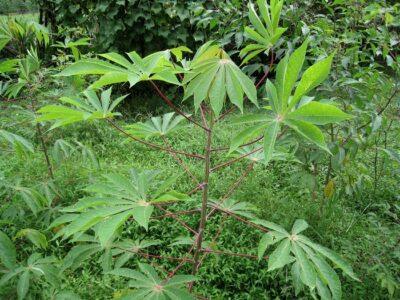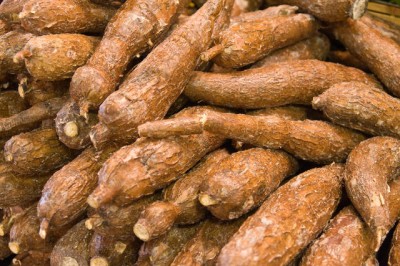
Image source: shelookbook.com
Cassava, or Manihot esculenta, is a root crop grown mainly in the tropical areas of the world. Originating in South America, it is now a staple for many people in African and Asian countries. Florida, with its relatively warm climate, also can sustain this crop very well, as can areas in Zones 8 and above. That’s just one of the reasons why this tuber should be part of any survival garden in warm weather areas.
What makes cassava ideal for a survival garden?
A survival garden should provide as much food security as possible with minimum use of resources. Not all plants are suitable; you should choose wisely to optimize space, time and other inputs with an eye on getting the maximum amount of high-quality nutrition. Cassava is an excellent source of carbohydrates, the primary fuel for our body.
It also is:
- A highly drought-resistant crop – Except for the first six weeks following planting, cassava does not require much additional irrigation. If cassava gets adequate moisture for a month or two after planting, it will manage on its own afterward. When planted immediately after the last frost, these plants can tide over long dry seasons without much damage.
- A safe bet against the vagaries of nature – Growing underground, the roots are not damaged even when the crown is lost to frost, storms or fire.
- Not too picky about soil – These plants grow in any soil, even in poor and clay-rich soil. Keep in mind though, well-drained, loamy soil is the best for good root run.
- A plant with a yield per square foot – Cassava gives more yield per square foot compared to other carbohydrate sources such as grains, yams, sweet potatoes and other tubers. Each plant can give you six to 10 pounds of tubers without much additional fertilizer. In intensive cultivation, you might get 20 pounds or more per plant. A single bunch can give you several days of a carbohydrate fix and can provide complete nutrition when eaten with beans, meat or other protein-rich foods.
- Able to stay in the ground – Even though the roots can be harvested six to eight months after planting, the crop can be left in the ground for up to 10 months or more, if there’s no threat of frost damage.
- Easily made into products for long-time storage – The roots can be frozen as such or after skinning. Or they can be dried as thick chunks or thin wafers for long-term storage. They can be grated, dried and powdered to make tapioca flour.
- Highly economical – Since no part of the plant is wasted, this crop meets the economy of space essential for survival crops. There’s no great recurring cost, either, as the stems can be made into planting sets after harvest.
- Relatively safe from marauders – Animals, or even humans, that could be raiding a survival garden in times of scarcity, cannot easily get to these roots.
- A concentrated energy source – Gram-per-gram, cassava has more than double the carbohydrate content and the total calories of potatoes. It is richer in certain minerals such as zinc, calcium, manganese and selenium. While the roots lack protein and fat, the leaves are protein-rich when cooked and contain many vitamins, including Vitamin K.
- Easy to grow – This is one of the greatest advantages of cassava.
Sourcing Planting Material
Mature stems are the main means of propagation. Ten-month-old canes that are one-inch or more in thickness are ideal. Each cane can give about six or more one-foot long cuttings. You can source a few sets from someone already growing cassava, or order it online.
Soil Amendments
Cassava can grow fairly well in most types of soil. But adding compost or manure and tilling the ground will improve the soil’s nutrient content and loosen it up so that the roots can easily run.
The Best Source For Heirloom Herb Seeds Is Right Here! [1]
You’ll want the roots to spread out far and wide in every direction to maximize the yield. The ideal pH is 5.5 to 7 for this crop.
Ensuring Drainage

Image source: galleryhip.com
The thick starchy roots can rot if they sit in water. To avoid this, cassava is typically planted in mounds of soil, two to three feet apart. Some people do ridges and furrows, with cassava on the ridges and some shade and moisture-loving vegetables in the furrows.
Planting the Sets
Check the stem for tiny buds; when the stem is right side up, they should be located above the projections of the leaf bases. Insert the bottom half of the stem into the soil at a slight angle so that the top will not be in the way of the new shoot that will grow vertically upwards.
These sets typically take root wherever they touch the soil, so there’s really no need for a rooting hormone. And once you have your first few plants up, you’ll have a steady supply of planting material to use, share and even sell.
Water thoroughly after planting and repeat watering three days later. Then water weekly for the next few weeks until the plants are established with vigorous shoots. Allow only the strongest shoots to grow.
Companion Planting
Some legumes like cow peas, runner beans or snap peas are usually grown along with cassava for the nitrogen they offer. In a survival garden, they can optimize space utilization, too. When planted together, the legume sprouts get a head start before the cassava spread out their leaves and then the climbers get free support on the cassava canes.
Harvesting the Leaves
The cassava leaves are nutritious and can supplement a survival diet. But, as with all parts of the plant, they can cause cyanide poisoning unless prepared well. Select leaves that are nearly mature and break off two to three leaves at a time from each plant. Cut them up and boil them for 15 minutes in plenty of water, which will remove the cyanide. Drain away the water and add the leaves to soups, stews or casseroles as you would do with spinach.
Harvesting the Roots
The roots should become plump and ready for harvest in six to eight months. Check them by digging next to the plant with a trowel until you reach a root. Scratch away the soil from around the root to expose it. Roots that are two inches or more in thickness are best, even though narrower ones are fine, too. Trace it back to the point where the root is attached to the stem and cut the root off at the narrow neck there.
The Secrets Of Sea Minerals To Grow More “Nutritionally-Dense Food” Than You Can Possibly Eat! [2]

Image source: fastcoexist.com
Boiling the root is the best way to determine how mature it is. Roots that are too young will have a new-potato texture with a slightly translucent look. The mature ones will be starchier and more opaque. If you’re fine with the taste and texture, you can go ahead and harvest more roots. If left in the ground beyond 10 to 12 months, the roots can become fibrous, though.
To lift a whole bunch off the ground with minimum damage:
- Thoroughly water the area the day before to loosen the soil.
- Cut off the stem one foot above the ground.
- Remove the topsoil with a rake until you see the top of some tubers.
- Gently move the stem back and forth and upward until it is loose.
- Lift up the bunch with a pickaxe by hooking it near the stem base.
- Check for broken tubers that you’ll need to dig up.
Using Cassava
The simplest way to use these tubers is to boil the root in salted water after removing the skin and cutting them into two- to three-inch long sections. Drain off the water after boiling for 15 minutes and then continue to boil until soft to touch.
Alternately, the boiled sections can be sliced thin and fried like potato crisps, or dried and stored for future use. You can find a hundred other ways to use it. They make excellent animal feed, too.
Overall, cassava is an entirely perfect survival crop. If you can grow it, it is a must!
Have you ever grown cassava? What tips would you add? Share them in the section below:
8 Reasons You Should Choose Heirloom Seeds. Read More Here. [3]